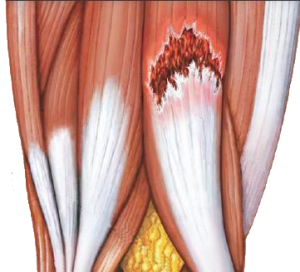Injury Profile: Strain (Pulled Muscle)
 What Is a Strain?
What Is a Strain?
As the name implies this injury occurs when the muscle is pulled or stretched beyond its capacity cause the fibers or tendons to tear. Strains can be rated mild, moderate or severe depending on how many muscle fibers are torn.
- Mild: few muscle fibers torn, accompanied by mild bruising and pain.
- Moderate: a lot of muscle fibers torn, noticeable bruising and it hurts pretty bad.
- Severe: a total tear (muscle can ball up because there’s no more tension), really bad bruising and PAIN LOTS OF PAIN!
Muscle spasms and swelling are also common when you pull a muscle.
What Are the Risk Factors?
- Physical activity, especially sports that involve running, jumping or kicking (think soccer, football, hurdles etc).
- Tight muscles
- Muscle fatigue or overexertion
- Cold weather
I Think I Just Pulled a Muscle.. What Do I Do?
Take a deep breath and remember a simple food: RICE. Ok so rice itself might not help in this situation, but it might help you remember these other things:
R- Rest, stop using the muscle!
I- Ice, yep dig out the cold stuff and apply to reduce swelling. Never apply ice directly to the skin, use a towel, nearby T-Shirt or mascot costume to protect your skin from freezing. Leave the ice on for 15-20 minutes and then allow your body to rest for 45-60 minutes before applying again.
C- Compression, wrap the area with a soft ACE- bandage to help reduce swelling.
E- Elevation, prop up the affected area to the level of your heart or at least as close as you can get. This will keep blood from pooling around the injury which is good because even though huge bruises are cool, blot clots are NOT.
Another trick to help your body sort itself out is to fire the opposite muscle. What could this possibly do to help? Running along your muscles are never fibers that help keep track of how much they are stretched. When your muscle is pulled beyond what it should this whole system gets messed up and the nerves can be irritated which equals pain. When you fire the opposite side it’s like hitting a reset button which can help those nerves to get re-aligned with the muscle. This also helps you to keeps circulation going to that area so the tissues can be fed and heal.
NOTE: To fire the opposite muscle doesn’t automatically mean that it’s on the opposite side of the body. Instead of thinking about location think about action. If the muscle you hurt is supposed to lift your arm then fire the muscles that are supposed to lower your arm. These actions should be done against resistance without actually moving the affected area.
When Should I Come in to Get Therapy?
There are two ways to look at this: first you can wait and see if it heals on its own. If you still have pain and limited range of motion after a while then definitely see a medical professional to get some help. At Synergy we can break up scar tissue, and reduce pain using techniques like Myofascial Release, Strain Counterstrain and Total Motion Release.
The other school of thought is why not stop permanent damage before it starts? To that end some professional sports teams have a therapist onsite with them to start therapy as soon as you get the injury. Lymphatic Drainage Therapy is particularly helpful right away because it helps reduce swelling while maintaining circulation to the area. Unfortunately most of us can’t our butler/physical therapist right over when we pull a hamstring trying to impress the kids… so then what? By coming in for an appointment right after the injury you can get it checked by a professional so see how bad it is, get training in how to take care of yourself and maybe even get some gentle treatment to help prevent further damage. Empowered by that information you can better take care of the injury yourself and then come in if it doesn’t get better (hey, that sounds a lot like the first way!).
 What Is a Strain?
What Is a Strain?
